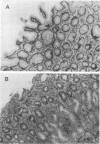Abstract
We used Japanese monkeys (Macaca fuscata) to establish an experimental model in order to clarify the pathogenicity of Helicobacter pylori in gastric and duodenal disorders. A suspension (5 ml; 10(9) CFU/ml) of H. pylori cells isolated from humans was sprayed around the antrum of the stomach of each of 12 of 17 animals with an endoscope. The remaining five animals were not inoculated; they served as a control group. On days 7, 14, and 28 after inoculation, the gastric mucosa samples were examined grossly and were biopsied for microscopic examination with an endoscope. H. pylori was recovered from 7 of the 12 inoculated animals (58%), and infiltration by neutrophils and monocytes was observed histologically. Macroscopic gastritis with erythema and erosions were noted for five of these animals. On day 28 after inoculation, five animals in the infected group were treated with ampicillin. In two infected but untreated animals, the bacteria persisted for more than 6 months. The result of the gastritis scoring of the antral mucosa and the ammonia concentration in the gastric secretion were significantly higher (P < 0.01 to 0.001) for the infected group than for the control group; however, these values decreased to levels comparable to those for the control group after treatment with ampicillin. Urease activity was positive in gastric biopsy specimens from five of the seven animals in the infected group after 7 days and from four of these animals after 14 days but was negative in all specimens from animals in the control group. The level of antibody (immunoglobulin G) in serum for the infected group was elevated but changed very little for the control group. These results suggest that this M. fuscata model can be used to study H. pylori infection and that H. pylori can induce gastritis.
Full text
PDF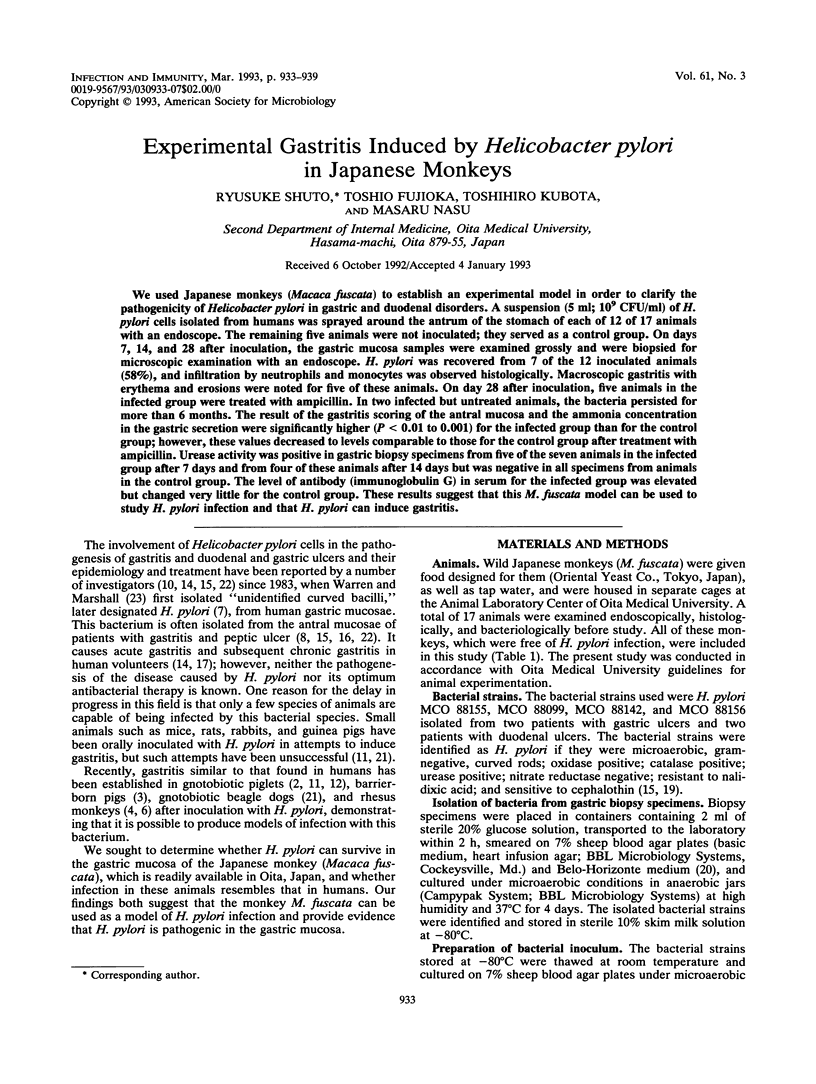
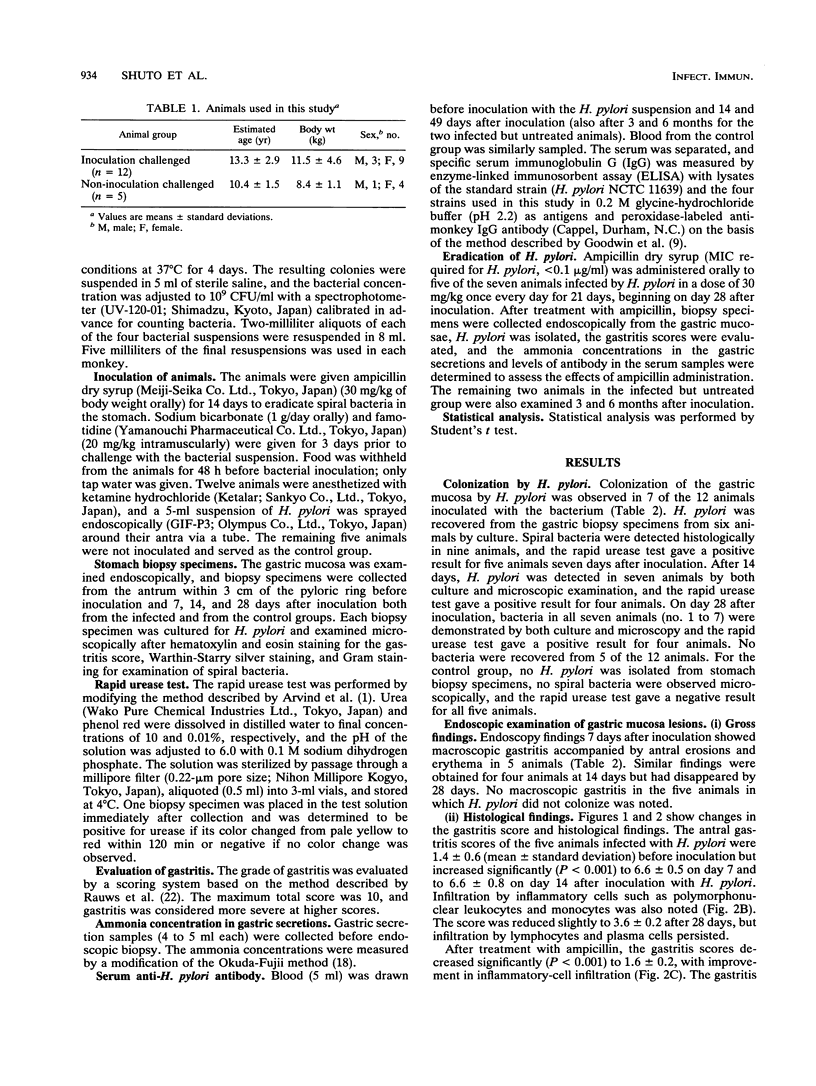
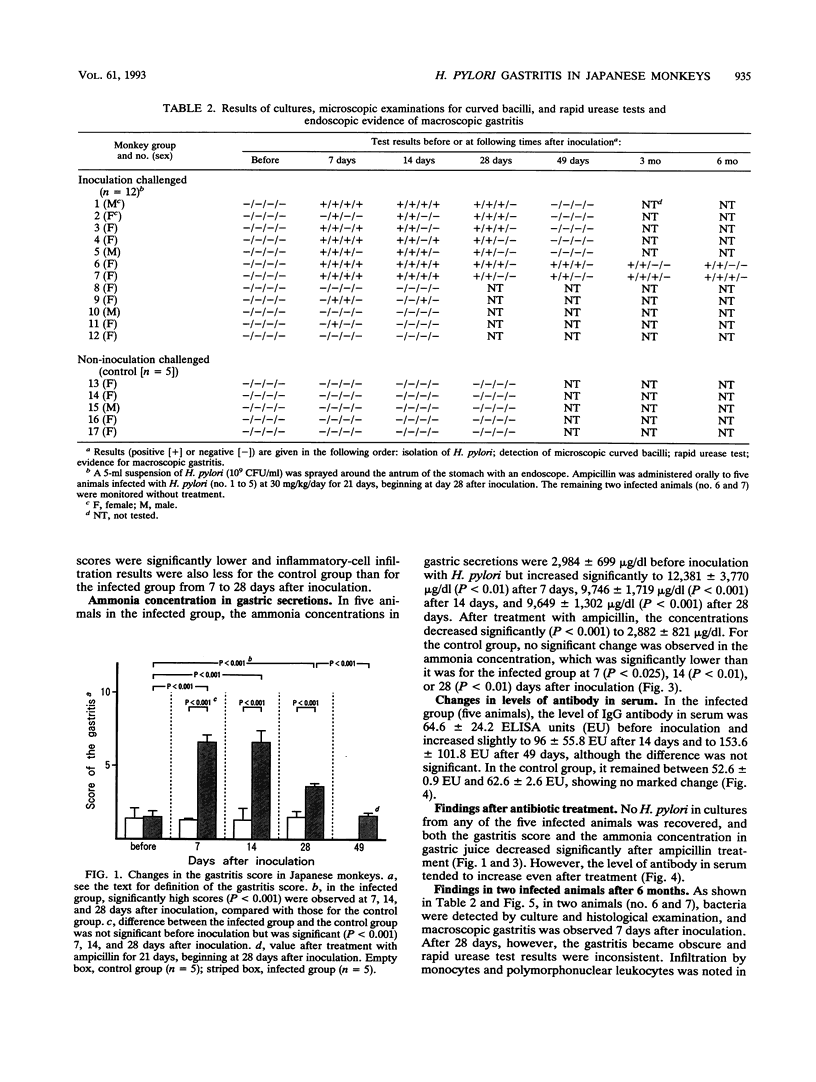
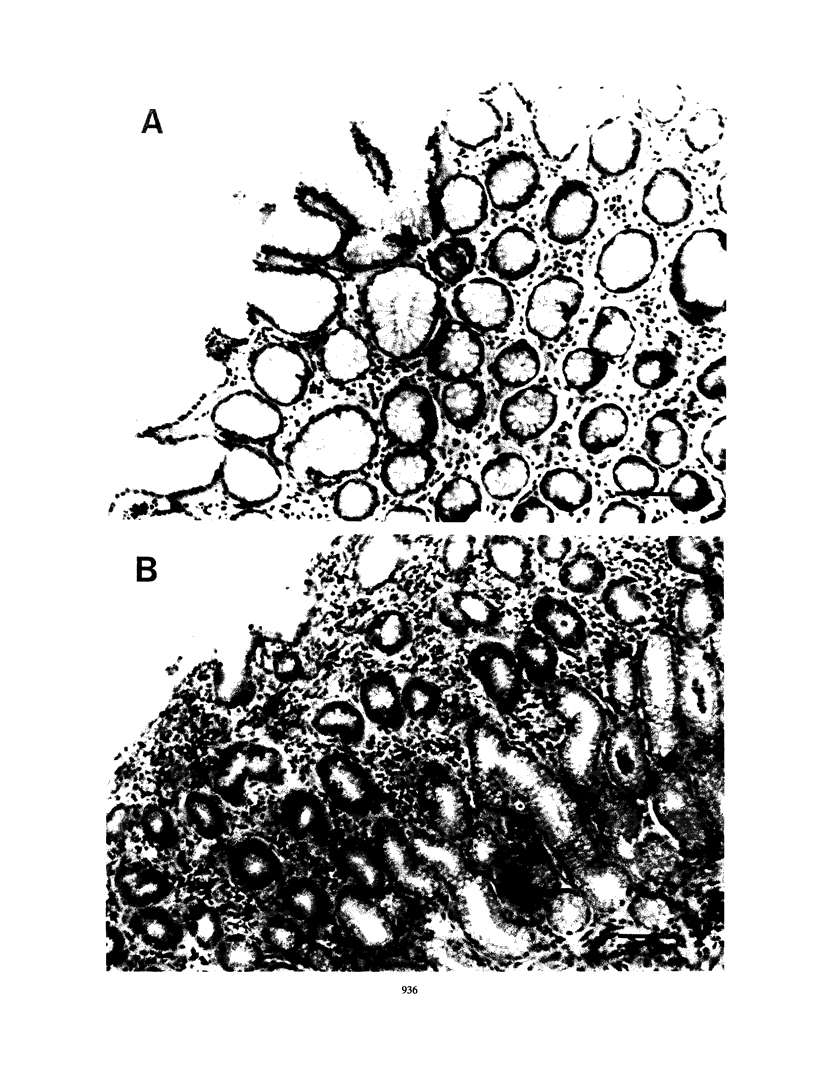
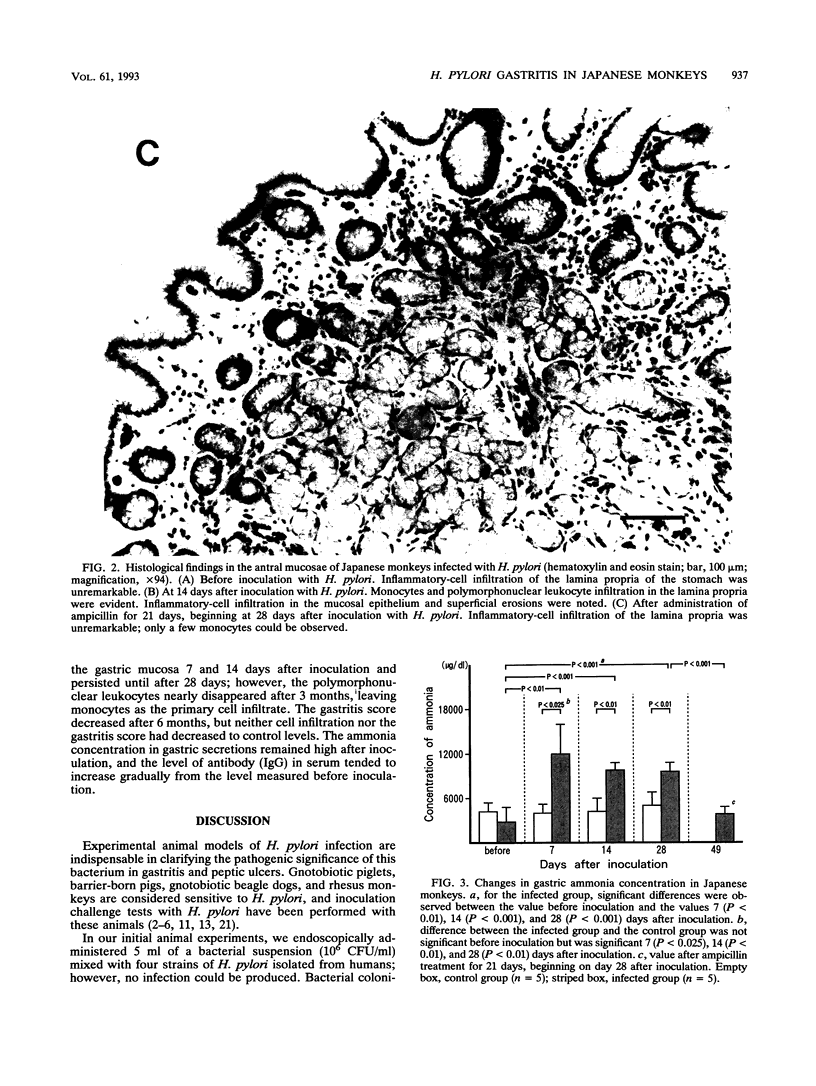
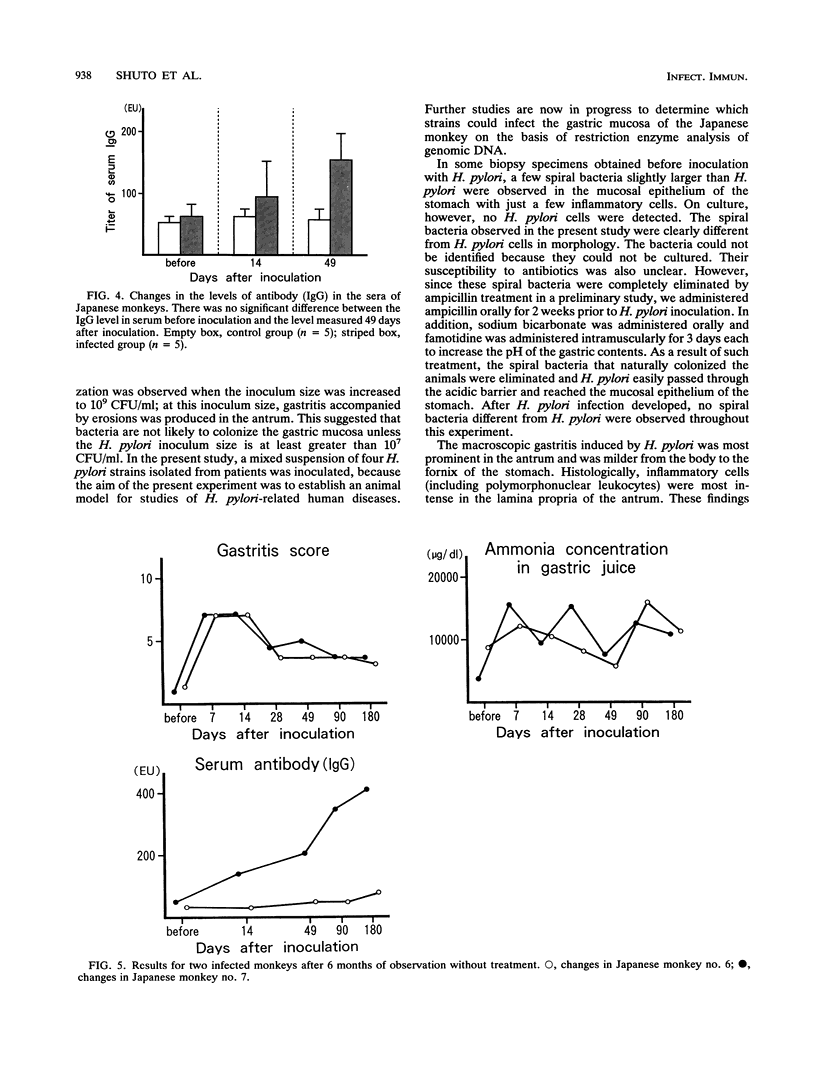
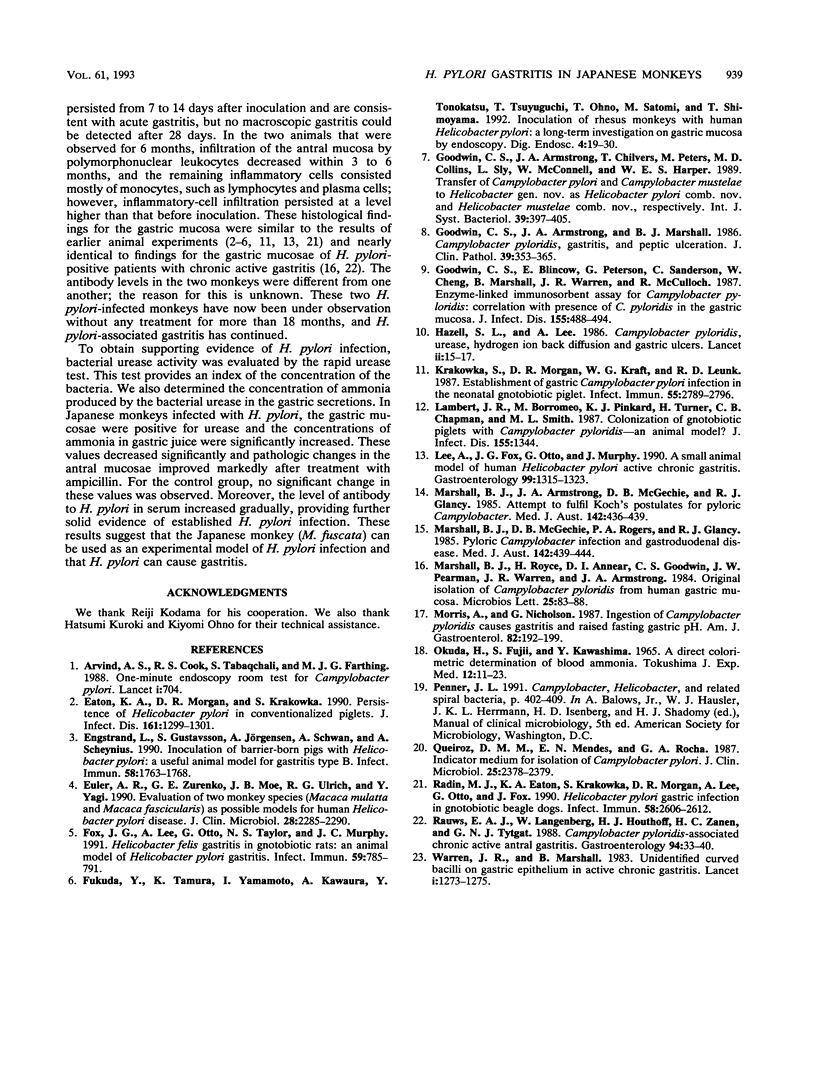
Images in this article
Selected References
These references are in PubMed. This may not be the complete list of references from this article.
- Arvind A. S., Cook R. S., Tabaqchali S., Farthing M. J. One-minute endoscopy room test for Campylobacter pylori. Lancet. 1988 Mar 26;1(8587):704–704. doi: 10.1016/s0140-6736(88)91501-2. [DOI] [PubMed] [Google Scholar]
- Eaton K. A., Morgan D. R., Krakowka S. Persistence of Helicobacter pylori in conventionalized piglets. J Infect Dis. 1990 Jun;161(6):1299–1301. doi: 10.1093/infdis/161.6.1299. [DOI] [PubMed] [Google Scholar]
- Engstrand L., Gustavsson S., Jörgensen A., Schwan A., Scheynius A. Inoculation of barrier-born pigs with Helicobacter pylori: a useful animal model for gastritis type B. Infect Immun. 1990 Jun;58(6):1763–1768. doi: 10.1128/iai.58.6.1763-1768.1990. [DOI] [PMC free article] [PubMed] [Google Scholar]
- Euler A. R., Zurenko G. E., Moe J. B., Ulrich R. G., Yagi Y. Evaluation of two monkey species (Macaca mulatta and Macaca fascicularis) as possible models for human Helicobacter pylori disease. J Clin Microbiol. 1990 Oct;28(10):2285–2290. doi: 10.1128/jcm.28.10.2285-2290.1990. [DOI] [PMC free article] [PubMed] [Google Scholar]
- Fox J. G., Lee A., Otto G., Taylor N. S., Murphy J. C. Helicobacter felis gastritis in gnotobiotic rats: an animal model of Helicobacter pylori gastritis. Infect Immun. 1991 Mar;59(3):785–791. doi: 10.1128/iai.59.3.785-791.1991. [DOI] [PMC free article] [PubMed] [Google Scholar]
- Goodwin C. S., Armstrong J. A., Marshall B. J. Campylobacter pyloridis, gastritis, and peptic ulceration. J Clin Pathol. 1986 Apr;39(4):353–365. doi: 10.1136/jcp.39.4.353. [DOI] [PMC free article] [PubMed] [Google Scholar]
- Goodwin C. S., Blincow E., Peterson G., Sanderson C., Cheng W., Marshall B., Warren J. R., McCulloch R. Enzyme-linked immunosorbent assay for Campylobacter pyloridis: correlation with presence of C. pyloridis in the gastric mucosa. J Infect Dis. 1987 Mar;155(3):488–494. doi: 10.1093/infdis/155.3.488. [DOI] [PubMed] [Google Scholar]
- Hazell S. L., Lee A. Campylobacter pyloridis, urease, hydrogen ion back diffusion, and gastric ulcers. Lancet. 1986 Jul 5;2(8497):15–17. doi: 10.1016/s0140-6736(86)92561-4. [DOI] [PubMed] [Google Scholar]
- Krakowka S., Morgan D. R., Kraft W. G., Leunk R. D. Establishment of gastric Campylobacter pylori infection in the neonatal gnotobiotic piglet. Infect Immun. 1987 Nov;55(11):2789–2796. doi: 10.1128/iai.55.11.2789-2796.1987. [DOI] [PMC free article] [PubMed] [Google Scholar]
- Lambert J. R., Borromeo M., Pinkard K. J., Turner H., Chapman C. B., Smith M. L. Colonization of gnotobiotic piglets with Campylobacter Pyloridis--an animal model? J Infect Dis. 1987 Jun;155(6):1344–1344. doi: 10.1093/infdis/155.6.1344. [DOI] [PubMed] [Google Scholar]
- Lee A., Fox J. G., Otto G., Murphy J. A small animal model of human Helicobacter pylori active chronic gastritis. Gastroenterology. 1990 Nov;99(5):1315–1323. doi: 10.1016/0016-5085(90)91156-z. [DOI] [PubMed] [Google Scholar]
- Marshall B. J., Armstrong J. A., McGechie D. B., Glancy R. J. Attempt to fulfil Koch's postulates for pyloric Campylobacter. Med J Aust. 1985 Apr 15;142(8):436–439. doi: 10.5694/j.1326-5377.1985.tb113443.x. [DOI] [PubMed] [Google Scholar]
- Marshall B. J., McGechie D. B., Rogers P. A., Glancy R. J. Pyloric Campylobacter infection and gastroduodenal disease. Med J Aust. 1985 Apr 15;142(8):439–444. doi: 10.5694/j.1326-5377.1985.tb113444.x. [DOI] [PubMed] [Google Scholar]
- Morris A., Nicholson G. Ingestion of Campylobacter pyloridis causes gastritis and raised fasting gastric pH. Am J Gastroenterol. 1987 Mar;82(3):192–199. [PubMed] [Google Scholar]
- Okuda H., Fujii S., Kawashima Y. A direct colorimetric determination of blood ammonia. Tokushima J Exp Med. 1965 May;12(1):11–23. [PubMed] [Google Scholar]
- Queiroz D. M., Mendes E. N., Rocha G. A. Indicator medium for isolation of Campylobacter pylori. J Clin Microbiol. 1987 Dec;25(12):2378–2379. doi: 10.1128/jcm.25.12.2378-2379.1987. [DOI] [PMC free article] [PubMed] [Google Scholar]
- Radin M. J., Eaton K. A., Krakowka S., Morgan D. R., Lee A., Otto G., Fox J. Helicobacter pylori gastric infection in gnotobiotic beagle dogs. Infect Immun. 1990 Aug;58(8):2606–2612. doi: 10.1128/iai.58.8.2606-2612.1990. [DOI] [PMC free article] [PubMed] [Google Scholar]
- Rauws E. A., Langenberg W., Houthoff H. J., Zanen H. C., Tytgat G. N. Campylobacter pyloridis-associated chronic active antral gastritis. A prospective study of its prevalence and the effects of antibacterial and antiulcer treatment. Gastroenterology. 1988 Jan;94(1):33–40. [PubMed] [Google Scholar]
- Unidentified curved bacilli on gastric epithelium in active chronic gastritis. Lancet. 1983 Jun 4;1(8336):1273–1275. [PubMed] [Google Scholar]



